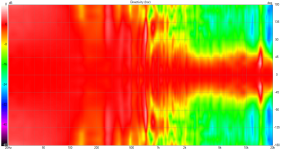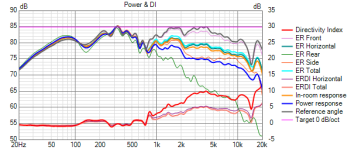If these are only present on axis there is nothing you can do with eq as this would harm all other axis.
How would you EQ this one?Unless you are a female under the age of 24, or a male under the age of 18, it is unlikely that you hear much above 16k.
I usually try to EQ a tweeter flat to 16k, and with Hypex FA this is easy. If this were a passive speaker, you would just have to live with it, and things like this are what make various tweeters sound different.
- notch up on the dip, notch down on the peak? (With overall tweeter attenuation)
- notch down on the peak, low shelf down from the dip? (Without overall tweeter attenuation
What you're seeing is an effect of the waveguide design. That's also why it looks different when you stick the microphone up against the tweeter dome.
Look at your off-axis response and imagine what would see if you bumped up the on-axis dip.
I would leave it alone for now. But it won't hurt anything to experiment and see if you can hear a difference.
Go get your better measurements. Then do the VCad thing, so you can weigh the trade offs between on and off axis repsonse before you make an actual decision.
Look at your off-axis response and imagine what would see if you bumped up the on-axis dip.
I would leave it alone for now. But it won't hurt anything to experiment and see if you can hear a difference.
Go get your better measurements. Then do the VCad thing, so you can weigh the trade offs between on and off axis repsonse before you make an actual decision.
This kind of irregularites we see with domes and waveguides, interference of cone/wg/horn cavity and perhaps also membrane/surround deformations. The worst scenario is a coaxial mid-tweeter, like in this case (modded SEAS MR18 in my project)
For audibility estimate measure response at least horizontally +/- 15 deg and make average. In your attached responses the effect is rather mild, but smoothing is too coarse, it hides the sharpest dip. Most likely there's no problem at all.
For audibility estimate measure response at least horizontally +/- 15 deg and make average. In your attached responses the effect is rather mild, but smoothing is too coarse, it hides the sharpest dip. Most likely there's no problem at all.
I agree. If you wanted to add a modest PEQ of about 2 dB at about 14k, you could probably flatten it out a bit, but this is low on the priority list.I would leave it alone for now. But it won't hurt anything to experiment and see if you can hear a difference.
Personally I dont like a lift in treble above 10K herz. It highly depends on recording whether a lift in treble disturb the experience. Or improve it.Unless you are a female under the age of 24, or a male under the age of 18, it is unlikely that you hear much above 16k.
I usually try to EQ a tweeter flat to 16k
I will be having another go at measurements in a large room (local church) end of May, hoping to produce a set with wider gating (compared to my small flat). My confidence level is very low, though.
I hope your measurements go well. I feel compelled to mention that I get very good measurement results with a gating (time window) of about 4 ms. I rarely need longer than that. I know there are some on this forum who erect towers to get a 10 ms + time window, but I have not found the need for that.
The nearfield scan is valid from very low frequency up to about the wavelength equivalent of pi*diaphragm diameter. This is about 500 Hz for a 10" woofer, about 650 Hz for 8" woofer, and about 850 Hz for a 6" woofer. A 4 ms gated far field measurement can go down to 500 Hz with 1/2 octave resolution, so that is good enough for a 10" woofer. Only with much larger woofers do we need longer gates to meet up with the near field data.
The merging process stitches together the low frequency near field data to the higher frequency far field data. Part of this process is converting the near field data from half space (2-pi) to full space (4-pi). The simple way to do this is based on the width of the cabinet. VituixCad uses a more sophisticated method bases on the whole baffle size and shape. It is a simple process to "draw" the baffle in the VituixCad diffraction tool and save the diffraction response. The merger tool then uses that diffraction response to accurately convert the nearfield data into full space equivalent.
I have compared the near field + far field merged response to outdoor ground plane measurements (the gold standard), and the agreement is quite good, within 1 dB. So even though it seems like there are a lot of moving parts and assumptions, the process does work well.
j.
I have just about managed the merging process in VCad but not yet the baffle simulation. Need to have a go. Can it be done after the merge, or does it have to be before?
Another question re nearfield merging: I plan to crossover at 250-300Hz LF to MF. So, do I just import and merge the woofer nearfield (and do not need the nearfield of MF and HF), or do I still need the MF and HF nearfields in VCad for some reason? the merging happens in the 300-400Hz region, right? so kinda no need for HF and MF?The required shelf filter may be much lower than that.
If I simulate a 160 mm wide baffle with a typical 5.5" woofer, I get a 4-pi response like this
View attachment 1448376
Here is a reasonable shelf filter to counteract that baffle step. A second order low-shelf of +6 dB at 275 Hz, Q=0.53
View attachment 1448377
View attachment 1448378
This is the filter that would work with an ideal 5.5" driver. Your woofers will have a response that is different, but this gives you an idea of what is reasonable.
Are you interested in going through the process of making near-field frequency response scans of each driver, then merging them to the time-windowed far-field response scans? This would give a quasi-anechoic response for each driver, and it would be a good way to start simulating the response. If you restrict yourself to only the on-axis response at this point, VituixCad is not too difficult to learn. Because your baffle shape and layout is already firmly defined, there is limited value in doing polar response scans... in other words, the directivity performance of this speaker is mostly fixed for this speaker, there is not much you can do to adjust it at this point. It is probably better to just focus on the on-axis performance and get that optimized first.
If you are interested in going down this path, you can start by making some near field scans of each driver.
This is a very good instructional thread on doing what you want to do: https://www.audiosciencereview.com/...ents-spinoramas-with-rew-and-vituixcad.21860/
The gating window size is restricted by the first reflection of your far field measurement, usually 3 -5 ms or similar. This window also defines the minimum frequency resolution, which is probably not enough for reliable midrange response but surely enough for the tweeter.do I still need the MF and HF nearfields in VCad for some reason?
So merging woofer and midrange is useful, but not necessary for the tweeter.
I can achieve 4ms in my room, but I get bad phase in these measurements. I do not know the cause, how to fix this or if/how this is important. I hope that larger room may fix that, but not sure of that either.I hope your measurements go well. I feel compelled to mention that I get very good measurement results with a gating (time window) of about 4 ms. I rarely need longer than that. I know there are some on this forum who erect towers to get a 10 ms + time window, but I have not found the need for that.
The nearfield scan is valid from very low frequency up to about the wavelength equivalent of pi*diaphragm diameter. This is about 500 Hz for a 10" woofer, about 650 Hz for 8" woofer, and about 850 Hz for a 6" woofer. A 4 ms gated far field measurement can go down to 500 Hz with 1/2 octave resolution, so that is good enough for a 10" woofer. Only with much larger woofers do we need longer gates to meet up with the near field data.
The merging process stitches together the low frequency near field data to the higher frequency far field data. Part of this process is converting the near field data from half space (2-pi) to full space (4-pi). The simple way to do this is based on the width of the cabinet. VituixCad uses a more sophisticated method bases on the whole baffle size and shape. It is a simple process to "draw" the baffle in the VituixCad diffraction tool and save the diffraction response. The merger tool then uses that diffraction response to accurately convert the nearfield data into full space equivalent.
I have compared the near field + far field merged response to outdoor ground plane measurements (the gold standard), and the agreement is quite good, within 1 dB. So even though it seems like there are a lot of moving parts and assumptions, the process does work well.
j.
Files from best attempt here.
Post in thread '3-way to active - Hypex FA253 - learning project'
https://www.diyaudio.com/community/...ex-fa253-learning-project.421061/post-7988085
When you do your measurements again, I recommend you save them as *.pir impulse response files, in addition to whatever you are doing now. I am not familiar with REW (I use ARTA) so I can't give you much advice on how to do it. VituixCad can import the *.pir files and process them in the proper way to keep the phase intact. As long as you follow the VituixCad instructions when making the measurements, you will be fine. A key point is to keep the same distance from mic to baffle when measuring all the drivers. Measure each driver on its own axis. This means you change the height of the mic, but don't change the left-right, for-aft position.
j.
j.
- Home
- Loudspeakers
- Multi-Way
- 3-way to active - Hypex FA253 - learning project

